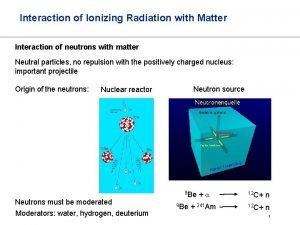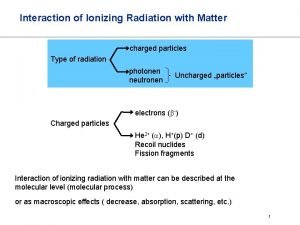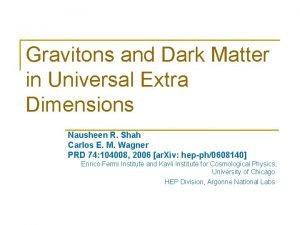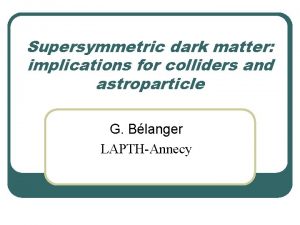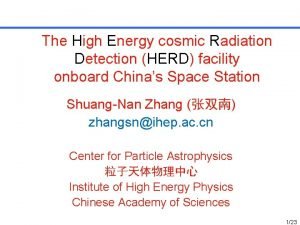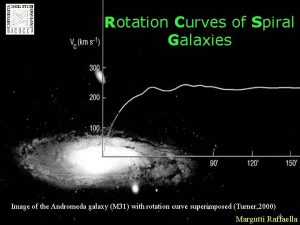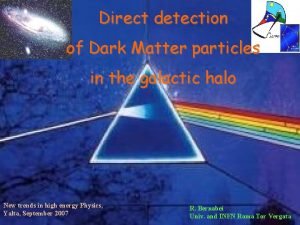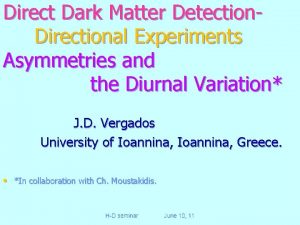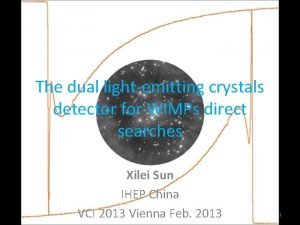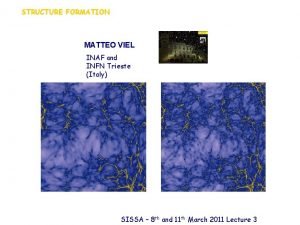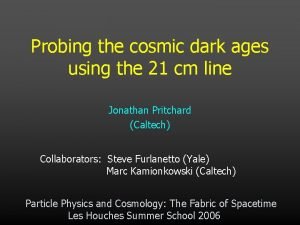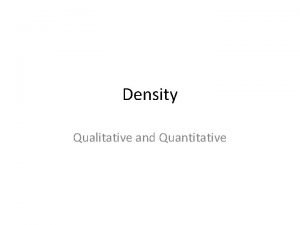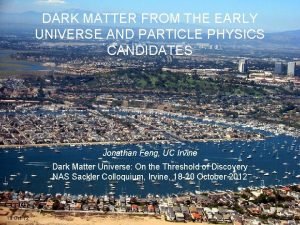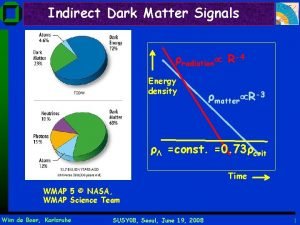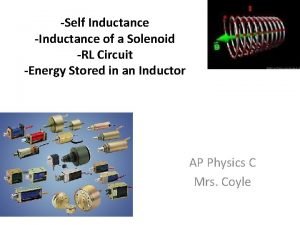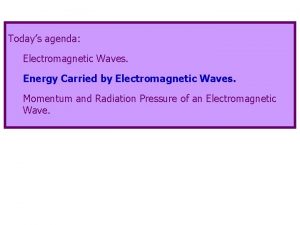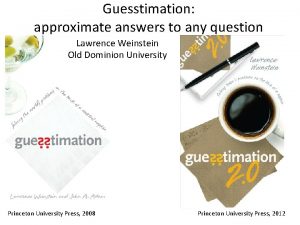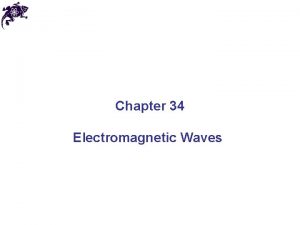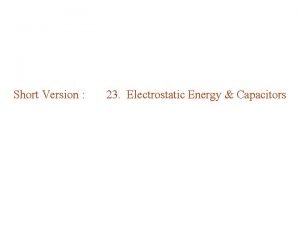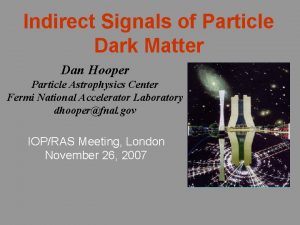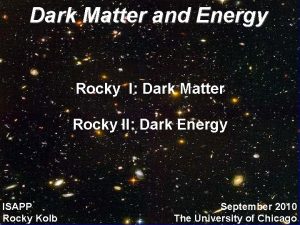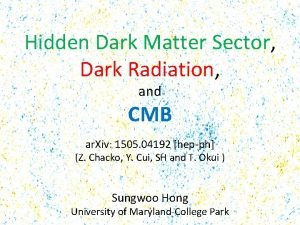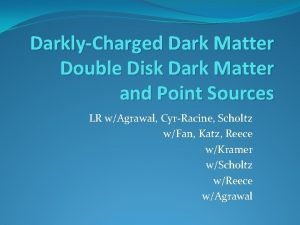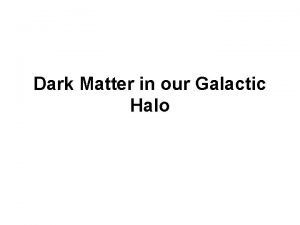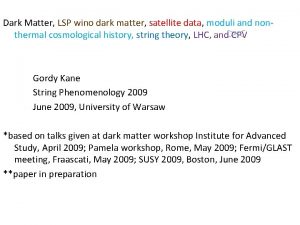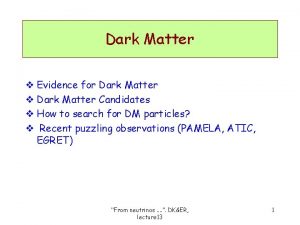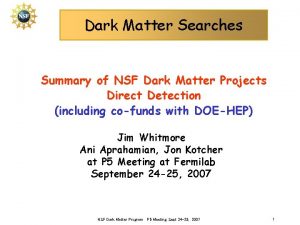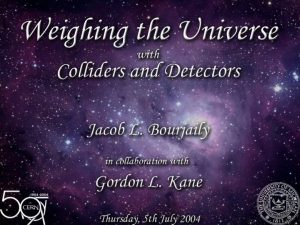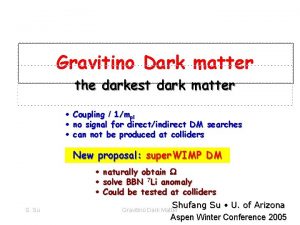Indirect Dark Matter Signals radiation R4 Energy density












































- Slides: 44

Indirect Dark Matter Signals ρradiation R-4 Energy density ρmatter R-3 ρΛ =const. =0. 73ρcrit Time WMAP 5 © NASA, WMAP Science Team Wim de Boer, Karlsruhe SUSY 08, Seoul, June 19, 2008 1

Expansion rate of universe determines WIMP annihilation cross section Thermal equilibrium abundance Comoving number density Actual abundance T>>M: f+f->M+M; M+M->f+f T<M: M+M->f+f T=M/22: M decoupled, stable density (wenn Annihilationrate Expansionsrate, i. e. =< v>n (xfr) H(xfr) !) WMAP -> h 2=0. 113 0. 009 -> < v>=2. 10 -26 cm 3/s DM increases in Galaxies: 1 WIMP/coffee cup 105 <ρ>. DMA ( ρ2) restarts again. . Annihilation into lighter particles, like quarks and leptons -> 0’s -> Gammas! T=M/22 x=m/T Jungmann, Kamionkowski, Griest, PR 1995 Wim de Boer, Karlsruhe Only assumption in this analysis: WIMP = THERMAL RELIC! SUSY 08, Seoul, June 19, 2008 2

Example of DM annihilation (SUSY) f ~ f f f W A f f Z f ≈37 gammas Z 0 W Z Dominant + A b bbar quark pair Sum of diagrams should yield <σv>=2. 10 -26 cm 3/s to get correct relic density Wim de Boer, Karlsruhe Quark fragmentation known! Hence spectra of positrons, gammas and antiprotons known! Relative amount of , p, e+ known as well. SUSY 08, Seoul, June 19, 2008 3

Two important experiments for DMA expected to deliver data: 1) PAMELA on antiprotons and positrons (started 2 years ago) 2) GLAST on gamma rays (started 2 weeks ago) Wim de Boer, Karlsruhe SUSY 08, Seoul, June 19, 2008 4

Delta II rocket Cape Canaveral GLAST launched in June, 2008 Wim de Boer, Karlsruhe SUSY 08, Seoul, June 19, 2008 5

PAMELA: Payload for Antimatter Matter Exploration and Light Element AAstrophysics Launched 15. 6. 2006 on board russian satellite with Soyez rocket. 16 GB/day Small, but beautiful. Big improvement over present balloon data Wim de Boer, Karlsruhe SUSY 08, Seoul, June 19, 2008 6

Two important new papers for DMA: 1) No CUSPY NFW profile anymore 2) Convection dominates propagation: reduces yield of charged particles from DMA by order of magnitude Wim de Boer, Karlsruhe SUSY 08, Seoul, June 19, 2008 7

diffuse The new NFW profile: NO Cusp for Clumps Einasto (CLUMPS) “Subhalos have also been found to be spatially biased relative to the smooth dark matter halo where they are embedded, avoiding in general the innermost regions” Ludlow, Navarro, Springel, Jenkins, Frenk, Helmi, ar. Xiv: 0801. 1127 EGRET Clumps inside clumps swung to larger orbits Consequence: Galactic Center not a point source for DMA anymore Wim de Boer, Karlsruhe SUSY 08, Seoul, June 19, 2008 8

NATURE 452, 17. April 2008, “Blown away by cosmic rays”, D. Breitschwerdt “Earlier models had shown that a steady state wind driven by cosmic rays pervading the entire Milky Way could blow away about a solarmass-worth of gas per year. Everett et al. find a similar gas loss of 2. 1 solar masses per year from the best fit to their X-ray data. In their picture, the cosmic-ray pressure is crucial to the existence of a large-scale wind in the Milky Way. “ Our parametrization from fitting all CR data with modified GALPROP NGC 253 Wim de Boer, Karlsruhe Fit to ROSAT data, Everett et al. ar. Xiv: 0710. 3712 v 1 SUSY 08, Seoul, June 19, 2008 9

Three independent measurements explained by convection dominated propagation 1. ROSAT X-Ray maps of hot gas in halo 2. Integral absence of positron annihilation in disk 3. Small gradient in EGRET diffuse gamma rays (in diffusive model MOST cosmic ray interactions with gas towards center of Galaxy, thus producing there diffuse gamma rays by inelastic collisions, NOT observed! (Breitschwerdt, Dogiel, Völk, A&A (2002)) CRs crossing disk in centre reduced by convection!! Wim de Boer, Karlsruhe SUSY 08, Seoul, June 19, 2008 10

Conventional diffusion model Properties: CR diffuse in leaky box Secondaries CR density x gas density CR Lifetime given by size of box DMA in diffusion dominated model: charged particles strongly enhanced compared with gamma rays, since gammas escape and charged particles rattle around for 107 yrs. This enhances Npb/Nγ. Enhancement factor: Npb/Nγ O(1) instead of expected O(10 -2) So DMA does not produce many antiprotons/positrons, but average density becomes large in a “storage tank” In convection dominated models most charged particles in halo are “blown by the wind”. Charged particle fluxes from DMA order of magnitude LOWER!!!!!!! Wim de Boer, Karlsruhe SUSY 08, Seoul, June 19, 2008 11

Convection dominates for low energies Diffusioncoeff: DR(R, Z)=DR 0 E 0. 33 DZ(R, Z)=DZ 0 E 0. 33 Wim de Boer, Karlsruhe V(R, Z)=V 0+Vdv/dz V(R) Galactic Wind SNR(R) Diff u dom sion inat ed conve c domin tion ated DZ 0>>DR 0 Our parametrization from fitting all CR data with modified GALPROP Consequence of large convection dominated region->observed CR spectra are LOCAL spectra. Lifetime and flux of secondaries determined by LOCAL gas density and propagation in R, not in Z. SUSY 08, Seoul, June 19, 2008 12

Secondary production (B/C) and cosmic clocks (10 Be/9 Be) B/C determines grammage 10 Be/9 Be B/C=secondary/prim. determines grammage (smaller than disk!) In diffusion dom. : by large halo In convection dom. : by slow diffusion in disk. Wim de Boer, Karlsruhe determines escape time 10 Be (t 1/2 = 1. 51 Myr) is cosmic clock: lifetime of cosmics 107 yrs. In diffusion dom. : by large halo In convection dom. : by slow diff. SUSY 08, Seoul, June 19, 2008 13

Indirect Dark Matter Signals • 511 ke. V emission from the galactic bulge • The HEAT positron excess • EGRET’s galactic gamma ray spectrum • EGRET’s extragalactic gamma ray spectrum • The WMAP haze Dan Hooper – SUSY 07 Indirect Searches For Particle Dark Matter Wim de Boer, Karlsruhe SUSY 08, Seoul, June 19, 2008 14

511 ke. V Emission from the Galactic Bulge • INTEGRAL/SPI observed bright 511 ke. V emission from the bulge of the Milky Way (1. 3 x 1043 positrons injected per second) • Gaussian, spherically symmetric morphology (FWHM of 8˚) • Sources of low energy positrons (low energy, else they do not annihilate): Radioactive nuclei from SNIa and other stellar objects Wim de Boer, Karlsruhe SUSY 08, Seoul, June 19, 2008 15

Positron production ONLY in SNIa From Nikos Prantzos Wim de Boer, Karlsruhe SUSY 08, Seoul, June 19, 2008 16

Distribution of gas and SNIa in Milky Way Surprisingly: SNIa emit most positrons in the halo, NOT in the disk With diffusion dominance they would return to disk and annihilate. With convection dominance they escape to outer halo. In the thick bulge they still find electrons to annihilate, so a large B/D is expected! JUST BECAUSE OF the different GEOMETRY of bulge and disk. Wim de Boer, Karlsruhe SUSY 08, Seoul, June 19, 2008 17

Usual astrophysicist search strategies Particle physicist: get rid of model dependence by DATA DRIVEN calibration Wim de Boer, Karlsruhe SUSY 08, Seoul, June 19, 2008 18

New data driven and model independent search strategy How it works: Main background: PCR + PGas -> 0 +X -> + X plus some electron induced BG at low energies Spectral shapes of all backgrounds KNOWN from collider experiments (main BG from fixed target exp. of proton beam on hydrogen target). Signal: + -> 0 +X -> + X has SAME spectrum as e+ + e- -> 0 +X -> + X Therefore: I KNOW spectral shapes of signal and background (which are VERY different), but I do not know absolute normalizations of signal and backg. Thus fit these -> DM distribution in whole sky independent of model for profile or model for backg. Also indep. of experimental normalization errors, just have to know relative norm. between diff. sky directions. z Wim de Boer, Karlsruhe SUSY 08, Seoul, June 19, 2008 19

Background shape known, if cosmic rays known No SM Quarks from WIMPS Protons Electrons Quarks in protons Protons diffuse much faster than energy loss time, so expect SAME shape everywhere. Indeed observed: outer Galaxy can be fitted with same shape as inner Galaxy. For electrons energy losses to be taken into account, but background from electrons small. Wim de Boer, Karlsruhe SUSY 08, Seoul, June 19, 2008 20

Background + signal describe EGRET data! Fitted known shapes of background and DMA (from accelerator experiments) with free normalizations. W. de Boer et al. , A&A (2005) Wim de Boer, Karlsruhe SUSY 08, Seoul, June 19, 2008 21

Analysis of EGRET Data in 6 sky directions A: inner Galaxy B: outer disc C: outer Galaxy Total 2 for all regions : 28/36 Prob. = 0. 8 Excess above background > 10σ. E: intermediate lat. D: low latitude A: inner Galaxy (l=± 300, |b|<50) B: Galactic plane avoiding A C: Outer Galaxy Wim de Boer, Karlsruhe F: galactic poles D: low latitude (10 -200) E: intermediate lat. (20 -600) F: Galactic poles (60 -900) SUSY 08, Seoul, June 19, 2008 22

Halo density on scale of 300 kpc (from normalization factors in 180 sky directions) Sideview Topview Cored isothermal profile with scale 4 kpc Total mass: O(1012) solar masses Wim de Boer, Karlsruhe SUSY 08, Seoul, June 19, 2008 23

Halo density on scale of 30 kpc Sideview Topview Enhancement of inner (outer) ring over 1/r 2 profile 6 (8). Mass in rings 0. 3 (3)% of total DM Wim de Boer, Karlsruhe SUSY 08, Seoul, June 19, 2008 24

The Milky Way and its 13 satellite galaxies Canis Major Tidal force ΔFG 1/r 3 Wim de Boer, Karlsruhe SUSY 08, Seoul, June 19, 2008 25

Tidal streams of dark matter from CM and Sgt CM Sun Sgt From David Law, Caltech Wim de Boer, Karlsruhe SUSY 08, Seoul, June 19, 2008 26

Observed stars N-body simulation from Canis-Major dwarf galaxy R=13 kpc, φ=-200, ε=0. 8 prograde Wim de Boer, Karlsruhe Canis Major (b=-150) retrograde SUSY 08, Seoul, June 19, 2008 27

Gas flaring in the Milky Way P M W Kalberla, L Dedes, J Kerp and U Haud, http: //arxiv. org/abs/0704. 3925 no ring with ring Gas flaring needs EGRET ring with mass of 2. 1010 M☉! Wim de Boer, Karlsruhe SUSY 08, Seoul, June 19, 2008 28

EGRET Excess predicts shape of rotation curve! Sofue &Honma v Inner rotation curve l. D to ta disk 1/r halo 2 R 0=7. 0 R/R 0 Note 1: Absolute value of rotation curve depends on distances. But chance of slope can ONLY be explained by ringlike structure. bulge Inner Ring Outer Ring Normalize to solar velocity of 220 km/s Wim de Boer, Karlsruhe Outer RC Black hole at centre: R 0=8. 0 0. 4 kpc M Rotation Curve R 0=8. 3 kpc Note 2: fact that shape of DM halo can describe shape of RC implies that EGRET excess has exactly right intensity to deliver grav. potential! SUSY 08, Seoul, June 19, 2008 29

The dark connection between Canis Major, Monoceros Stream, gas flaring, the rotation curve and the EGRET excess From EGRET excess of diffuse Galactic gamma rays • Determination of WIMP mass • Determination of WIMP halo (= standard halo + DM rings) Wd. B, C. Sander, V. Zhukov, D. Kazakov, A. Gladyshev A&A, 444 (2005) 51 Confirmation: • Rotation curve • Canis Major/Monoceros stream • Gas flaring Objections • EGRET data wrongly calibrated? • Antiproton flux too high? • WMAP haze different profile? • Extraterr. Gamma rays inconsist? • Direct searches exclude Egret? Wim de Boer, Karlsruhe Physics = correlations Richard Feynman Rotation curve Astronomers Tidal streams Gas flaring Astrophysics Cosmics Gamma rays 23%DM, thermal history of WIMPs Cosmology Annihilation x-section Tidal disruption of dwarf satellites Gamma ray Particle Physics spectra for BG + DMA SUSY 08, Seoul, June 19, 2008 30

Comparison of convection and diffusion dominated propagation Convection dominated Diffusion dominated (Bergstrom, Edsjo, Gustafsson and Salati, JCAP, astro-ph/0602632) Summary: preferred propagation perp. to disk reduces contribution of charged particles from DMA by large factor and can be consistent with B/C and 10 Be/9 Be Wim de Boer, Karlsruhe SUSY 08, Seoul, June 19, 2008 31

Positron spectrum can be tuned to arbitrary shape by Galactic Magnetic Fields (constrained by synchrotron maps) Chung et al, ar. Xiv: 0710. 2428 v 1 He at +A MS 01 dat a Note: propagation parameters do NOT cancel in ratio e+/(e+ + e-), since e+ from + decays, mainly produced locally by cosmic rays on gas of disk, while e- from SN explosions, produced far away! Wim de Boer, Karlsruhe SUSY 08, Seoul, June 19, 2008 32

The WMAP Haze HASLAM 408 MHz Haz e CR syn Haze: Hooper, Dobler and Finkbeiner, ar. Xiv: 0705. 3655 AP M W Egret DM Shape of Haze perfectly consistent with EGRET excess Magnitude of Haze has large uncertainties from B-field towards Galactic centre and spectral shape of electrons. Wim de Boer, Karlsruhe SUSY 08, Seoul, June 19, 2008 33

THE EXTRAGALACTIC GAMMA RAY BACKGROUND 2/ d. o. f= 10. 9/6 2/d . o. f P=0. 1 =4. 7 /4 m =5 0 G e. V P =0. 3 D. Elssässer and K. Mannheim, Phys. Rev. Lett. 94: 171302, 2005 Problem: large excess since they ignore DMA signal in foreground Wim de Boer, Karlsruhe W. de Boer et al. , A&A, 2007 astro-ph/0705. 009 Phys. Rev. Lett. . 95: 209001, 2005, SUSY 08, Seoul, June 19, 2008 34

What about Supersymmetry? Assume m. SUGRA 5 parameters: m 0, m 1/2, tanb, A, sign μ Wim de Boer, Karlsruhe SUSY 08, Seoul, June 19, 2008 35

Expected SUSY mass spectra in m. SUGRA: common masses m 0 and m 1/2 for spin 0 and spin ½ particles Wim de Boer, Karlsruhe SUSY 08, Seoul, June 19, 2008 36

Large m 0, small m 1/2 preferred by many Allanach and Hooper, “natural priors”, ar. Xiv: 0806. 19 23 EW data +WMAP ar. Xiv: 0705. 2012 Baer, PPC 08, and ar. Xiv: 0805. 1905 ar. Xiv: 0803. 0510 “EW + WMAP” + “SO(10) Yukawa Unification” + “EGRET” ALL lead to the same scenario of light gauginos, heavy scalars ‘ Wim de Boer, Karlsruhe SUSY 08, Seoul, June 19, 2008 37

Gauge unification perfect with SUSY spectrum from EGRET Update from Amaldi, d. B, Fürstenau, PLB 260 1991 SM SUSY NO FREE PARAMETER With SUSY spectrum from EGRET + WMAP data and start values of couplings from final LEP data perfect gauge coupling unification! Also b->s and g-2 agree within 2σ with SUSY spectrum from EGRET Wim de Boer, Karlsruhe SUSY 08, Seoul, June 19, 2008 38

Comparison with direct searches Note: N 90%CL=n < 90%CLv> MS D C To get 90%CL one has to assume v and n : v assume Maxwellian and NO corrotation of DM halo n : assume DM mass from rotation curve to be completely diffuse. Theory: x-section can be order of magnitude lower due to matrix element uncertainties Conclusion: can easily move up exp. limits by order of magn. and move down theory by order of magnitude. Wim de Boer, Karlsruhe SUSY 08, Seoul, June 19, 2008 39

Clustering of DM Diemand et al. , Nature 2005, astro-ph/0501589: The earth passes through a dark matter mini-halo every 10, 000 years, an encounter which lasts for about 50 years, therefore most of the time the earth is within an UNDERDENSE region of dark matter. An artist picture of what we should see if our eyes were sensitive to 3 Ge. V gamma rays and we are flying with 220 km/s (=speed of sun) through the DM halo Wim de Boer, Karlsruhe Consequently the averaged DM density on a large scale (from the rotation curve) has very little to do with the LOCAL DM density! SUSY 08, Seoul, June 19, 2008 40

Large uncertainties in direct scattering x-section Ellis, Olive, Savage, ar. Xiv: 0801. 3656 Wim de Boer, Karlsruhe SUSY 08, Seoul, June 19, 2008 41

Summary Indirect detection: (SPACE EXPERIMENTS) intriguing hint for signals from DMA for 60 Ge. V WIMP from gammas NEW: convection dominated propagation model -> antiprotons New N-body simulations -> no CUSP for CLUMPS anymore GLAST and PAMELA will deliver much more precise data soon. Comparison with Direct Detection: (UNDERGROUND OBSERV. ) expected to observe signal in near future IF we are not in VOID of clumpy DM halo AND x-sections are favorable. Direct production: (ACCELERATORS (LHC 2008 -2018)): IF WIMP are Lightest Supersymmetric Particle (LSP) THEN WIMPs observable in DECAY of SUSY particles IF EVERY METHOD measures 60 Ge. V WIMP mass, then PERFECT. In this case Dark Matter is supersymmetric partner of the CMB! Wim de Boer, Karlsruhe SUSY 08, Seoul, June 19, 2008 42

BACK UP SLIDES Wim de Boer, Karlsruhe SUSY 08, Seoul, June 19, 2008 43

EGRET miscalibrated? EGRET Na. I calorimeter calibrated in SLAC photon beam. Could backscatter from calorimeter trigger charged CR veto? This would reduce flux at high energies, NOT produce excess. Overcorrected? Stecker et al. ar. Xiv: 0705. 4311 claim there is no excess by applying up to 85% corrections. But excess SHOULD not start around 1 Ge. V and quoted EGRET errors MUCH smaller. Detailed study by BAUGHMAN et al. ar. Xiv: 0706. 0503 v 1 using GLAST Monte Carlo adapted for EGRET show that EGRET excess is correct or even slightly larger. It would indeed be a very peculiar incident if the miscalibration simulates a text book signature of DMA Wim de Boer, Karlsruhe SUSY 08, Seoul, June 19, 2008 44
 Dark matter and dark energy presentation
Dark matter and dark energy presentation Energy naturally flows from warmer matter to cooler matter.
Energy naturally flows from warmer matter to cooler matter. Communicative signals and informative signals
Communicative signals and informative signals Language
Language Communicative signals and informative signals
Communicative signals and informative signals In the dark dark town
In the dark dark town What is interaction of radiation with matter
What is interaction of radiation with matter Wkipedia
Wkipedia Dark matter just gravitons dimensions
Dark matter just gravitons dimensions Boosted dark matter
Boosted dark matter Dark matter
Dark matter Dark matter pwo
Dark matter pwo Dark matter physics
Dark matter physics Where to stream dark matter
Where to stream dark matter What could dark matter be
What could dark matter be Cindms
Cindms Matteo viel
Matteo viel Dark matter
Dark matter Les houches dark matter
Les houches dark matter Indirect form of solar energy
Indirect form of solar energy Define specific gravity
Define specific gravity Bcc 111 planar density
Bcc 111 planar density What does arithmetic density tell us
What does arithmetic density tell us Linear atomic density
Linear atomic density High density low density
High density low density Ap human geography physiological density
Ap human geography physiological density Density qualitative or quantitative
Density qualitative or quantitative Section 1 composition of matter
Section 1 composition of matter Grey matter
Grey matter Section 1 composition of matter
Section 1 composition of matter Chapter 2 matter section 1 classifying matter answer key
Chapter 2 matter section 1 classifying matter answer key Median and lateral apertures
Median and lateral apertures Section 1 composition of matter chapter 15 answer key
Section 1 composition of matter chapter 15 answer key Gray matter and white matter
Gray matter and white matter What is grey matter
What is grey matter Energy energy transfer and general energy analysis
Energy energy transfer and general energy analysis Energy energy transfer and general energy analysis
Energy energy transfer and general energy analysis Cube of stabilized dark energy
Cube of stabilized dark energy Dma dark energy
Dma dark energy Inductance of solenoid formula
Inductance of solenoid formula Energy density of em wave
Energy density of em wave Xkcd uranium energy density
Xkcd uranium energy density Maxwell theory of electromagnetic waves
Maxwell theory of electromagnetic waves Electrostatic energy density
Electrostatic energy density Magnetic energy density
Magnetic energy density






